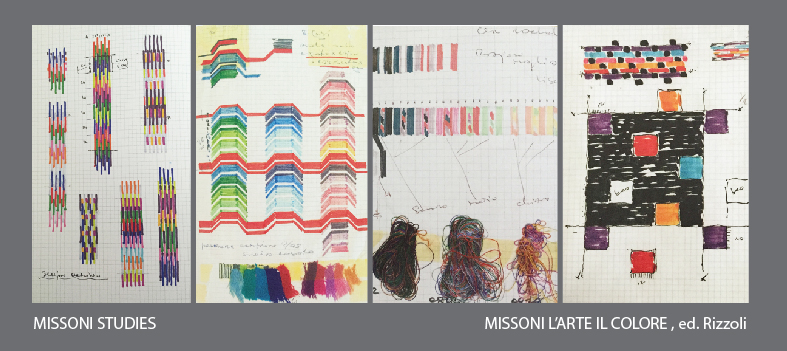It is a Sunday morning in October, sunny and warm, a perfect day to experience color that has long postponement, is my journey into the colorful world of the Missoni family at the Museum MA*GA Gallarate, near Varese.
At the entrance of the exhibition space, along a short corridor, on a gray wall has impressed a large white letters:
“They are pieces from museums, but wear them well”
It would seem an advertising slogan the title chosen by Maria Pezzi for the article on the presentation of Missoni in 1979, and that with great curiosity takes me in the first room of the House of Fashion. The environment is completely dark, there are only four large screens that continuously project movies and illuminate my path. The video of the Ali Kazma a Turkish artist, produced in the Missoni factories in 2009 , shows some phases of production, a series of threads, colors, skeins, ritual gestures and precise, accompanied by the sound of machinery. You enter virtually in the company, the place of production, where material and color take shape.
The Roots room:
Roots light on the origins of Missoni’s research, their initial resources and sources of inspiration, in the field of visual arts and fashion”
There are compositions of signs, colors, geometric shapes, created by the great masters of the contemporary European. I dwell long to grasp the rules of the Color that I perceive in each of them, but a big tapestry down the room invites me to continue toward the color, material, shape.
I enter a large room dimly lit and with the dark walls, there are huge bags full of wool yarn, each of a different color: white, green, purple, orange, red, magenta, blue, yellow and cornflower blue. Surrounded by the softness of wool, I headed to the installation “Machine-Magician“, so defined by Guido Ballo about a work of Ottavio Missoni for the exhibition at the Gallery Navigliovenezia in 1975.
“The idea is that of a forest … rows of multicolored light that through our presence we can cross … a fabric that materializes around us. This is the charm of the color takes shape.”
Luca Missoni
As Alice in Wonderland I find myself catapulted into another dimension, an enchanted forest of stretch fabrics, multicolor, that make me discover the other side of the room, dominated by fifteen panels that frame to many pieces of colorful fabrics. A riot of colors that stand out in the dark. The color is taking shape and it does explicitly in the next room, Forms of Fashion.
It returns to the light, not more dark walls, but the colored hanging wires that frame to 100 dresses on exhibition, made over the years by the Missoni Maison. A little further on, nine multi-colored blazers are framed on the wall. I sense a slight undercurrent of sounds, a symphony is produced by textile machinery of Missoni factory:
“The sound is like a long thread in the Symphony Textiles”
I reach a small room and here I spell listening to the Dialogues on Color, by Ottavio and Rosita Missoni:
“At the beginning we were famous for the lines …”
“The color has no boundaries of any kind” Ottavio
“Without colors I can not live” Rosita
“There can not be a world without color, everything is colored around, let’s see the flowers, butterflies …” Ottavio
“Who said that the colors are 7! There are tones ” Rosita
“The colors and matter are my components” Ottavio
“The purple color blends in quite well with the other colors … such as purple with green …” Ottavio
“To dress in white and black is a defense” Rosita
“The black color serves to bring out the other colors” Ottavio
The work and studies on the color of Ottavio Missoni, along with works by artists after World War II, color the white walls and spaces of the exhibition. Signs, geometry, harmony, color tests made with markers on sheets of graph paper are the basis of the textile creations of the Maison.

“My father said that a fabric” it reads. ” You have to read to find out whether “it works”, holding it in your hand or narrowing his eyes a little to insulate it from the environment, or by dropping it on the floor of a dark gray carpet of the study. ”
Luca Missoni
My journey ends in a charming room, The tapestry room, where you can see large tapestries made of patchwork of knitted fabric. Since the ‘70s, Ottavio Missoni
“elects them as exclusive technique of artistic expression, able to concentrate in a particular way the cross interests, both in fashion and art, for material and color.”
I go out of the museum gratified by the emotions that color through this exhibition has given me, with harmony and rhythm.
